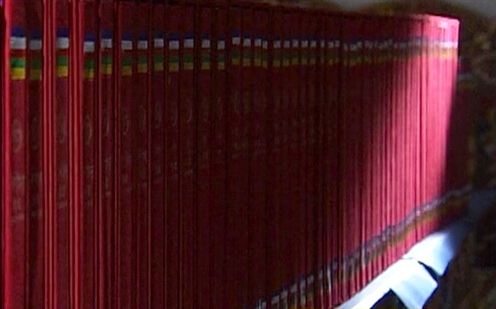Vincenzo Vergiani et al, eds. December 2017. Indic Manuscript Cultures through the Ages. Material, Textual, and Historical Investigations. Berlin, Boston: De Gruyter. Studies in Manuscript Cultures 14. ISBN 978-3-11-054310-0. doi:10.1515/9783110543100 [PDFs 🔓]
Eltschinger (2017), Why did Buddhists adopt Sanskrit?
Vincent Eltschinger. 2017. ‘Why did the Buddhists adopt Sanskrit?’ Open Linguistics 3 (Topical Issue on Historical Sociolinguistic Philology, ed. by Chiara Barbati and Christian
Gastgeber), pp.308–326. doi:10.1515/opli-2017-0015 [PDF 🔓]
Facsimile Edition of All Palmleaf MSS in the TAR (2012?)
བོད་རང་སྐྱོང་ལྗོངས་སུ་ཉར་ཚགས་བྱས་པའི་ཏ་ལའི་ལོ་མའི་དཔེ་ཆ་ཀུན་བཏུས་པར་མ།
《西藏自治区珍藏贝叶经影印大全》(共61分册)
*Facsimile Edition of Palmleaf Manuscripts in the Tibet Autonomous Region: Complete Collection. 2012(?). 61 vols.བོད་རང་སྐྱོང་ལྗོངས་སུ་ཉར་ཚགས་བྱས་པའི་ཏ་ལའི་ལོ་མའི་དཔེ་ཆ་ཀུན་བཏུས་ཀྱི་དཀར་ཆག་བསྡུས་པ།
《西藏自治区珍藏贝叶经影印大全简目》
*Facsimile Edition of Palmleaf Manuscripts in the Tibet Autonomous Region: Complete Collection. Brief Index. 2012(?).བོད་རང་སྐྱོང་ལྗོངས་སུ་ཉར་ཚགས་བྱས་པའི་ཏ་ལའི་ལོ་མའི་དཔེ་ཆ་བྲིས་མའི་རྩ་བའི་དཀར་ཆག།
《西藏自治区珍藏贝叶经总目录》(共4册)
*Master Catalogue of Palmleaf Manuscripts in the Tibet Autonomous Region. 2012(?). 4 vols.

Continue reading “Facsimile Edition of All Palmleaf MSS in the TAR (2012?)”
KL Dhammajoti, Reading Buddhist Sanskrit Texts (2012)
Kuala Lumpur Dhammajoti. Reading Buddhist Sanskrit Texts. An Elementary Grammatical Guide. Hong Kong: Buddha-dharma Centre of Hong Kong, 2012. ix + 361 pp. ISBN 978-988-16820-1-7 [available from Swindon Books]
A book that finds and almost fills its niche. Some weirdness is apparent, like the fact that sentences in romanized transcription do not appropriately add white space after finals. There are numerous typos and mistakes in sandhi, and there are no keys to the exercises — always a severe limitation. However, a patient and competent reviewer could easily detect, report and fix most of these problems. Any effort to knock down the high walls erected around the study of Sanskrit in ‘the West’ is, of course, worth encouraging.
From the Preface
“There are many excellent Sanskrit primers […] However, they all share the common feature of being based on non-Buddhist sources […]
many Buddhist students […] need to spend a large amount of time getting acquainted with those texts which are neither their concern proper nor source nor inspiration […]. It is out of this consideration that […] I had been thinking of producing an elementary manual totally based on the Buddhist texts” (p. v).

